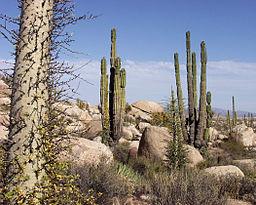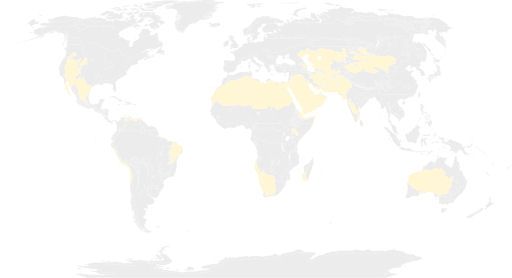Biosphere Contents
6. Biomes
Deserts are characterised by extreme water shortage and a very wide diurnal temperature range

Deserts cover 26-35% of the Earth's land surface, concentrated in bands between 15 to 30° north and south of the Equator. They experience extreme water shortage: rainfall is usually less than 25 cm per year. They also experience a very wide range of temperatures, from the hot deserts of the Sahara to the cold deserts, such as the Gobi Desert in Mongolia. Diurnal temperature also fluctuates widely, because of the small amount of plant cover and limited cloud cover, maxima of 57°C have been recorded during the heat of the day in the Sahara, falling to as low as 2°C at night. There are proportionally more annual plants in desert biomes than in any other biome. These plants can adapt to the levels of rainfall in a particular season, producing a variable number of flowers. Many will germinate only if appropriate rainfall conditions occur.
Few animals and plants are adapted to live in such dry, harsh environments. Cacti are commonly associated with deserts because they have adapted to store water and conserve it through physiological adaptations such as a modified form of photosynthesis, thick, impervious, waxy cuticles and water storage in their succulent stems. Reptiles are commonly found here, and often have specific adaptations to collect water - e.g. the Thorny Devil Lizard of Central Australia which has spines to collect water as it condenses at night. The spines have grooves which are directed towards the mouth.

Geographically deserts tend to be concentrated between thirty degrees north and south of the Equator, but local conditions can also create deserts, such as the rain shadow produced by a mountain range, e.g. the dry salt lakes of Nevada, in the rain shadow of the Sierra Nevada.
What are the main characteristics of the desert biome?